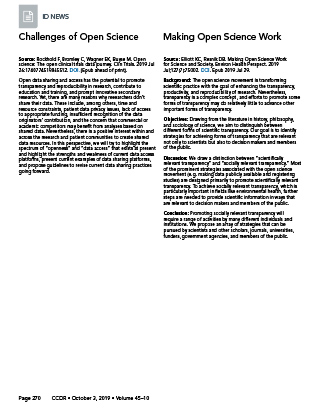Archived - The challenges to Open Science and how to make it work

 Download this article as a PDF
Download this article as a PDFPublished by: The Public Health Agency of Canada
Issue: Volume 45–10: Open Science / Open Data
Date published: October 3, 2019
ISSN: 1481-8531
Submit a manuscript
About CCDR
Browse
Volume 45–10, October 3, 2019: Open Science / Open Data
ID News
Challenges of Open Science
Source: Rockhold F, Bromley C, Wagner EK, Buyse M. Open science: The open clinical trials data journey. Clin Trials 2019 Jul 26:1740774519865512. https://doi.org/10.1177/1740774519865512. [Epub ahead of print]
Open data sharing and access has the potential to promote transparency and reproducibility in research, contribute to education and training, and prompt innovative secondary research. Yet, there are many reasons why researchers don't share their data. These include, among others, time and resource constraints, patient data privacy issues, lack of access to appropriate funding, insufficient recognition of the data originators' contribution, and the concern that commercial or academic competitors may benefit from analyses based on shared data. Nevertheless, there is a positive interest within and across the research and patient communities to create shared data resources. In this perspective, we will try to highlight the spectrum of "openness" and "data access" that exists at present and highlight the strengths and weakness of current data access platforms, present current examples of data sharing platforms, and propose guidelines to revise current data sharing practices going forward.
Making Open Science Work
Source: Elliott KC, Resnik DB. Making Open Science Work for Science and Society. Environ Health Perspect 2019 Jul;127(7):75002. https://doi.org/10.1289/EHP4808. Epub 2019 Jul 29.
Background: The open science movement is transforming scientific practice with the goal of enhancing the transparency, productivity, and reproducibility of research. Nevertheless, transparency is a complex concept, and efforts to promote some forms of transparency may do relatively little to advance other important forms of transparency.
Objectives: Drawing from the literature in history, philosophy, and sociology of science, we aim to distinguish between different forms of scientific transparency. Our goal is to identify strategies for achieving forms of transparency that are relevant not only to scientists but also to decision makers and members of the public.
Discussion: We draw a distinction between "scientifically relevant transparency" and "socially relevant transparency." Most of the prominent strategies associated with the open science movement (e.g. making data publicly available and registering studies) are designed primarily to promote scientifically relevant transparency. To achieve socially relevant transparency, which is particularly important in fields like environmental health, further steps are needed to provide scientific information in ways that are relevant to decision makers and members of the public.
Conclusion: Promoting socially relevant transparency will require a range of activities by many different individuals and institutions. We propose an array of strategies that can be pursued by scientists and other scholars, journals, universities, funders, government agencies, and members of the public.
